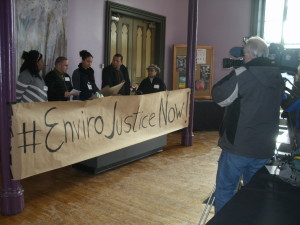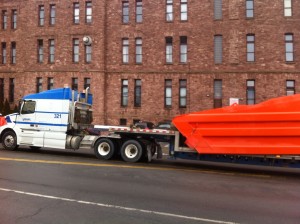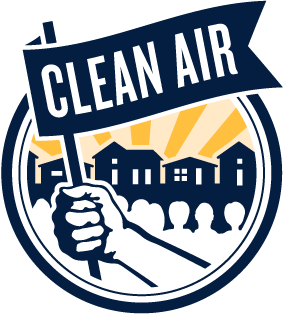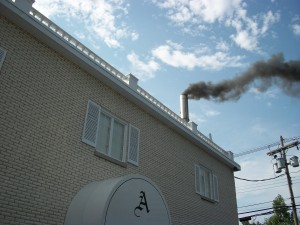US District Attorney in Tonawanda Coke Criminal Case to Meet with Public
US District Attorney in Tonawanda Coke Criminal Case to Meet with Public
Clean Air continues efforts to keep potential fines local
Aaron J. Mango, Assistant U.S. Attorney on the landmark case against Tonawanda Coke Corporation will provide a sentencing update to the public. Residents and workers who have or potentially have been impacted by the company are encouraged to attend. This is an important meeting in order to continue the fight to keep potential fines local and controlled by impacted communities.
Nearly a year ago, the Tonawanda Coke Corporation was found guilty of violating the Clean Air Act and Resource Conversation and Recovery Act. Este veredicto histórico es sólo la segunda vez en la historia de Estados Unidos que una empresa ha sido acusada en virtud de la Ley de Aire Limpio., and will set precedent for future cases. The company could face up to $200 millones de dólares en multas.
El verano pasado, Clean Air led a Campaña to keep the potential criminal fines local and used to fund community controlled projects in the most impacted neighborhoods. Casi 600 residents cast votes for how they think the funds should be used. This work resulted in the Department of Justice recommending $12,794,182 go towards community service projects. The ultimate decision resides with the Judge.
Sentencing for both Tonawanda Coke Corporation and Mark Kamholz is scheduled for March 19, 2014 en 10:00 AM before U.S. District Court Chief Judge William Skretny in theFederal Courthouse at 2 Niagara Square (9th floor), Búfalo, Nueva York
CUANDO: lunes, Marzo 10ª de 6 a 8 p.m.
DÓNDE: River Road Fire Hall, 39 Avenida Kaufman. Tonawanda 14150
Clean Air Joins Peabody Residents in Concrete Crusher Fight!
This Wednesday the Clean Air Board of Directors vote unanimously to join with residents on Peabody St. in the Seneca Babcock neighborhood to stand up against Battaglia Inc.
batalla inc. is located at 1037 Calle Séneca. Búfalo, Nueva York. The company’s property line comes up against the property of homeowners and renters on Peabody St., a densely populated community in South Buffalo. The company is a demolition transfer site, which temporary stores debris from housing demolition. Battaglia also engages in concrete crushing on site. Due to the activities of the company, there are a high number of trucks coming in and out of the facility, loading and unloading trash and debris.
The company has been in operation for less than 10 años. In this timeframe Battaglia has been cited numerous times by the Department of Environmental Conservation for violation of its 360 Waste Transfer Permit.
Clean Air became aware of the issue after our office has received numerous complaints from residents living near the company. Examples of complaints we have received as follows:
“The kids always have headaches from all the dust from the rock crushing, photos falling off of the wall from the house shaking because of all the trucks up and down the street.”
“No puedo abrir mis ventanas debido a todo el polvo de la roca que aplasta. A mis hijos les resulta difícil jugar afuera porque hay muchos camiones arriba y abajo de la calle.… My kids are always getting bloody noses and all I hear all day long is the beeping from the trucks.”
We are excited to work with the dedicated and courageous Peabody St. residentes. Stay tuned to see this campaign progress…
Join us at at a Just Transition Assembly
Huntley, located in the Town of Tonawanda, is Erie County’s last coal-burning power plant. A recent reporte by the Institute for Energy Economics and Financial Analysis stated Huntley is “experiencing average annual pre-tax earnings of a negative $1 million and does not appear to be financially viable”. The report estimates that as recently as 2005, the plant was making $110 million a year and that the plant lost $1 million per year between 2009 y 2012. The report goes on to call on community and corporate leadership.
According to the IEEFA’s press release, former First Deputy New York State Comptroller Tom Sanzillo, report co-author and director of finance, IEEFA, dijo: “The challenges posed by the Huntley plant can be handled by the region if planning starts now. We estimate there are less than 70 employees who may be affected by a coal plant retirement. The goal of our plan is to provide every employee with opportunities for a stable, long term income. The weak financial condition of the Huntley plant creates a revenue risk for the Town of Tonawanda, its Highway Department, Erie County and the Ken-Ton School District. By far the largest and most important NRG payment is to the Ken-Ton School District. As the plant’s financing deteriorates, tax payments to the district will become smaller. The actual budget for 2012 for the district was $135 y abogar ante los funcionarios públicos sobre la contaminación y las molestias de la demolición de Battaglia. Payments from the Huntley plant constitute 5.9 percent of actual district expenditures for 2012. With adequate planning, the loss of revenue from the Huntley plant need not result in a sudden jolt to the school district budget.”
We must make sure that if the plant retires, que los trabajadores de la planta y los residentes que viven cerca de la planta estén protegidos. Debemos asegurarnos de que se aseguren nuevos ingresos para nuestras escuelas y gobiernos locales., y para una limpieza de la propiedad frente al mar.
Join us for a Just Transition Assembly where we will:
- Share the financial report about Huntley
- Brainstorm what residents, trabajadores, and local governments will need in the future
- Identify community priorities
SATURDAY, March 1st 3pm: Boys and Girls Club at 54 Riverdale Rd in the Town of Tonawanda
MONDAY, March 3rd, 6pm: Grand Island Memorial Library 1715 Bedell Rd. Grand Island
THURSDAY, March 6th 6pm: Northwest Community Center at 155 Lawn Ave in Buffalo
THURSDAY, March 13th at 6pm Tonawanda City Hall, 200 Niagara St. in the City of Tonawanda
Los residentes del lado oeste revelan soluciones de sentido común para los problemas de calidad del aire
#EnviroJusticiaAhora!
“Me alegró mucho ver que los funcionarios en Washington han reconocido nuestros problemas de calidad del aire., y por la oportunidad de iniciar una conversación sobre lo que mis vecinos y yo necesitamos para respirar”, dijo Tangia Delk, un residente del lado oeste y miembro de Clean Air.
“Agradecemos los recursos de Washington para ayudarnos a abordar la epidemia de asma del West Side., pero la justicia ambiental requiere que los residentes afectados estén en el asiento del conductor. Los residentes de West Side y los miembros de Clean Air han estado hablando de soluciones durante años y queremos una conversación abierta y honesta dirigida por los residentes afectados sobre cómo combatir la mala calidad del aire en el vecindario”, dice Natasha Soto..
“Necesitamos un plan integral para el Puente de la Paz. Tenemos las soluciones a nuestros problemas de calidad del aire y queremos tener la oportunidad de verlas implementadas”, dijo Nicole Roberts, miembro de Clean Air, que vive detrás de Peace Bridge Plaza.
Los miembros creen firmemente que expandir la plaza de camiones más hacia este vecindario de justicia ambiental y continuar construyendo infraestructura de camiones exacerbará la crisis de asma en el lado oeste.. Esta es una lucha a largo plazo en la que la Coalición está comprometida.. Sin embargo, la comunidad tiene varias soluciones de sentido común que podrían ser financiadas por la ciudad de Buffalo, Estado de Nueva York, y el Gobierno Federal hoy dia ese ayudaría a hacer del lado oeste un vecindario más saludable.
Soluciones de sentido común a los problemas de calidad del aire en el lado oeste
Desarrollado por los miembros de Clean Air: Organizando por la Salud y la Justicia que viven, trabajar y jugar en el lado oeste inferior de Buffalo.
Los miembros creen firmemente que expandir una plaza de camiones más adentro de este vecindario de justicia ambiental y continuar construyendo infraestructura de camiones exacerbará la crisis de asma en el lado oeste.. Esta es una lucha a largo plazo en la que la Coalición está comprometida.. Sin embargo, la comunidad tiene varias soluciones de sentido común que podrían ser financiadas por la ciudad de Buffalo, Estado de Nueva York, y el Gobierno Federal hoy dia ese ayudaría a hacer del lado oeste un vecindario más saludable. Nuestros funcionarios públicos deben:
- Supervise los productos químicos que más nos preocupan, en los lugares que más nos preocupan. Ampliar el proyecto de monitorización del aire a los meses de verano, añadir más monitores, prueba de partículas ultrafinas y nos permite tener cierto control sobre el diseño del estudio.
- Invertir en amortiguadores verdes en lugares de alto tráfico. Financiar un proyecto piloto para un muro verde entre nosotros y los lugares de alto tráfico para protegernos del ruido, humos diesel y luces brillantes. Nos gustaría ver que el programa piloto se lleve a cabo en un área de mucho tráfico en nuestro vecindario, como la rampa que sale de Virginia Street o la rampa para camiones que bordea Front Park.. Esto se ha hecho en California con mucho éxito..
- Hacer cumplir las leyes contra el ralentí. El NYS DEC debería hacer de nuestro vecindario una prioridad y asignar oficiales para que pasen más tiempo en nuestro vecindario para evitar el ralentí en las calles laterales.. La Autoridad del Puente de la Paz debería aumentar la vigilancia en la plaza.
- Plantar arboles. Trabaje con nosotros para identificar las mejores ubicaciones y luego financiar plantaciones de árboles que sean más que decorativas y actúen como amortiguadores..
- Contratar más agentes de aduana. El senador Schumer señaló hace solo unos meses que esto no era un problema de infraestructura.; esto es un problema de personal.
- Financiar clínicas de salud y exámenes de asma. No tenemos suficientes médicos en nuestro vecindario.. Invierta en nuestras clínicas de salud y proveedores de atención médica.
- Financiar sistemas de filtración de aire para nuestros centros comunitarios, iglesias y escuelas.
- Tratarnos como iguales. Deja de hablar de nosotros y de nuestro alrededor. Invítenos a la mesa para hablar de soluciones, y asegúrese de que todos se presenten en la mesa. Nos referimos a todos ustedes: alimentado. Carretera, PUNTO DEL ESTADO DE NUEVA YORK, la PBA, el diciembre, y nuestros funcionarios electos locales como el concejal Rivera y Pridgen, congresista higgins, asambleísta ryan, y los senadores Grisanti y Kennedy.
- Haga que las reuniones públicas sean PÚBLICAS. Estamos orgullosos de la diversidad racial y lingüística de nuestro vecindario.. Celebrar reuniones en los idiomas que hablamos, y trabaje con nosotros para desarrollar reuniones que faciliten aportes significativos de la comunidad.
- Invertir en las calles de nuestros barrios. Nuestras calles y aceras están en mal estado por los camiones de 18 ruedas que recorren nuestro vecindario a diario.. Esto hace que caminar a la iglesia y al supermercado sea peligroso para las muchas personas mayores que viven en nuestra comunidad.. Y hace que sea menos probable que nuestros jóvenes jueguen afuera y reciban el tipo de ejercicio que necesitamos para estar saludables.. Necesitamos nuestros caminos pavimentados, bordillos arreglados y mejor iluminación en nuestro barrio.

Clean Air Calls for Full Investigation into Tonawanda Coke Explosion
Clean Air is extremely concerned about the explosion today at the Tonawanda Coke Plant in the Town of Tonawanda. We understand the company stated this was a minor explosion and a small fire but past self reporting from the company has been inaccurate and has put workers and residents at risk.
! Comment Period Extended for Peace Bridge Project !
Great news!
We did it! After numerous letters from residents and organizations living and working on the West Side, the Dept. of Transportation has extended the comment period for the draft environmental impact statement (DEIS) until Enero 28ª!
This gives us all a little more time to tell the DOT how we feel about the NY Gateway Project, and what improvements we want made. Don’t know where to start? Then join us for a workshop on how to write a comment letter, what alternatives can be included, and the different types of mitigation we can demand from the DOT and Federal Highway.
Join us because the West Side is your neighborhood and the DOT should not get to tell you how it should look or feel like.
Qué: Comment Writing Workshop
Cuando: Jueves, Enero 23rd en 5:30 PM
Donde: Niagara Branch Library (280 Porter Avenue)
Call us if you need a ride! 716.852.3813.
! Noticia buena!
! Los hicimos! Residentes y organizaciones que viven y trabajan en el West Side mandaron muchas cartas para que el Depto. De Transportaciones extendieran el ultimo día que están aceptando comentarios para el Borrador de Declaración de Impacto Ambiental ¡y ganamos!
El último día para someter comentarios es el 28º de enero dándonos más tiempo para someter comentarios al proyecto NY Gateway. ¿No sabes cómo empezar? Bueno, vamos a tener un taller ensenado como escribir comentarios, que alternativas podemos pedir, y que tipos de mitigación necesitamos.
Adjúntate con nosotros porque el West Side es tu vecindario y el DOT no tiene el derecho diciéndote como deber ser.
Que: Taller para aprender a Someter Comentarios Federales
Cuando: jueves, 23 de enero a las 5:30 PM
Adonde: Biblioteca Niagara (280 Avenida Porter)
Llamen si necesitas que te recojan.

Hope and History – 15 de enero
Aire limpio: Organizing for Health and Justice was founded by residents in Tonawanda, NY who suspected that their health problems were linked to the 53 plantas industriales en su vecindad. Residents conducted their own research, joined together with their neighbors to build the power of their community, and forced enforcement agencies and decision makers to take action.
Since then our work has grown. Our fight has expanded to work not only to reduce toxics in the Tonwandas, but also to address the asthma epidemic on Buffalo’s west side. Fighting for justice can be difficult, overwhelming, and never ending. This is why remembering and celebrating community wins is not only meaningful, but necessary.
“If you lose hope, somehow you lose the vitality that keeps life moving, you lose that courage to be, that quality that helps you go on in spite of it all.”
Martin Luther King Jr.
On January 15th, Clean Air members will share their stories of hope and how their experience fighting for justice led them to become agents for change. We hope you join us!
Miércoles, 15 de enero * 7pm
St. Timothys Church
1453 Staley Rd, Grand Island, Nueva York 14072
A People’s Guide to the Draft Environmental Impact Statement
The Government plans on spending $28.5 Million on the West Side.

Want to know where trucks are being rerouted in your neighborhood?
Want to know how the project will impact your health?
Want to make sure you can still get to Front Park? To LaSalle Park?
Then join us on Tuesday December 10ª for a Teach-In to learn:
- About the laws the Department of Transportation must follow, and the social movement that fought for them
- What the Department of Transportation is proposing to spend $28.5 Million on
- How to prepare public comments for the BIG public meeting on December 18ª
Rides to and from the meeting are being provided! Call us at 716-852-3813 if you need a ride. Snacks will be served, and kids are welcome.
Cuando: Martes, Diciembre 10ª
Time: 6- 8 PM
Localización: Hispanics United of Buffalo, 254 Virginia Street
El Departamento de Salud presenta el estudio final sobre el cáncer de Tonawanda
Tonawanda, NY – El Departamento de Salud del Estado de Nueva York presentará los resultados finales de su estudio de cáncer de Tonawanda el miércoles, De noviembre 6ª en el Centro Comunitario Sheridan Parkside (169 Sheridan Parkside Dra.) en Tonawanda & el jueves, De noviembre 7ª en San. Iglesia de Timoteo (1453 Staley Rd.) en isla grande.
NYS DOH encontró que el cáncer de pulmón, cáncer de vejiga, y el total de cánceres fue elevado entre hombres y mujeres; el cáncer de esófago fue elevado entre los hombres y el cáncer de útero fue elevado entre las mujeres. En subáreas, la cavidad oral se elevó entre los hombres, y leucemia entre las mujeres. Los partos prematuros y los defectos cardíacos también aumentaron.
En su informe final, el DOH incluyó la recomendación de realizar un futuro monitoreo biológico de los residentes de Tonawanda, incluida la toma de muestras de sangre y orina para evaluar la exposición tóxica.
Los residentes de Tonawanda solicitan que cualquier investigación adicional sobre la salud conduzca a un cambio en las políticas y regulaciones públicas..
Tonawanda, NY tiene la mayor concentración de instalaciones reguladas por aire en el estado. La comunidad está extremadamente preocupada por los altos niveles de diferentes contaminantes del aire de más de 53 planos industriales en el barrio. Según el DEC, la concentración media anual de seis tóxicos del aire (1,3-butadieno, acetaldehído, acroleína, benceno, tetracloruro de carbono, y formaldehído), cada uno excede las concentraciones de referencia anuales basadas en la salud.
Los residentes están pidiendo al Departamento de Salud que tome un papel activo para informar a los legisladores y le piden al Departamento de Salud que forme un grupo de trabajo con el Departamento de Conservación Ambiental enfocado en reducir las exposiciones tóxicas..
“Creo que el Estado espera que el cáncer en Tonawanda simplemente desaparezca.,dijo Durward Carter, residente de Tonawanda, “No va a. El cáncer está relacionado con la contaminación de nuestro aire. Necesitamos acción”.
Ambas presentaciones comenzarán a las 19:00 horas..
Amigone Calls Attorney General’s Lawsuit Frivolous
Amigone Funeral Home Inc. moved to dismiss a suit filed by the New York State Attorney Generals office, calling neighbors’ concerns– many who are elderly- frivolous. El crematorio, que tiene un largo historial de generar olores ofensivos, hollín y ruido excesivo, has been the source of persistent community complaints for decades.
“Even after reading sworn affidavits from 43 residentes, Miembros de la junta de la ciudad de Tonawanda, and reports from the Department of Environmental Conservation, the Amigones still don’t believe that their crematory causes a nuisance,” said Carol Fritsch, who lives close to the crematory. “I’m shocked.”
“It was a terrible smell, a stench.” States resident and veteran Norman Dehn in his affidavit, “Most of the time I smelled the odors in the evening.”
“The Crematory created problems for me.” Stated 97 year old resident Mary Calleri in her affidavit, “It made me more isolated because the odors forced me indoors. This happened too many times.”
Tonawanda residents are encouraged by the Attorney General’s suit especially in light of the Amigone’s recent statements indicating their intent to reopen. On August 12th, the Amigones along with their attorney and public relations consultant, met with 6 residents to discuss their intent to reopen. The family sent a letter to neighboring residents a few weeks later, indicating they intended to restart the crematory on the parcel next store to their current location.
“I felt abused when I was notified he wanted to reopen,” said neighbor Mary Ann Dickerson, “I don’t understand why a family business would operate this way, after knowing we’ve had to live with the smoke and smell coming from his operation.”
According to the suit, the Attorney General seeks injunctive relief against the Amigones to protect the public welfare and the environment. In his October 2Dakota del Norte press release Attorney General Schneiderman stated, “The Amigone crematory has cast a shadow of this Tonawanda community for too long. Las emisiones molestas ofensivas del crematorio han plagado durante mucho tiempo a los residentes., interfering with such basic pleasure as opening windows and enjoying backyards. This lawsuit will reassure this community that the Amigone crematory will never again pollute their air and disrupt their lives.”
Clean Air ha estado activo en la lucha para evitar que el crematorio opere cerca de las casas., working closely with home owners in the densely populated community adjacent to Amigone’s Tonawanda location.
Motions will be heard by Judge Henry Nowak on November 6ª en 9:30am in Erie County Supreme Court (25 Delaware Ave.. Búfalo) Parte 25. Residents will be available for comment.

